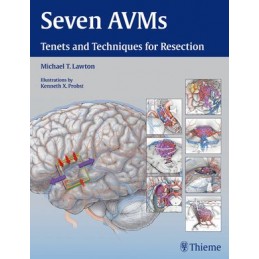- Obniżka

Zamawiaj do paczkomatu

Płać wygodnie


 Dostawa
Dostawa
Wybierz Paczkomat Inpost, Orlen Paczkę, DHL, DPD, Pocztę, email (dla ebooków). Kliknij po więcej
 Płatność
Płatność
Zapłać szybkim przelewem, kartą płatniczą lub za pobraniem. Kliknij po więcej szczegółów
 Zwroty
Zwroty
Jeżeli jesteś konsumentem możesz zwrócić towar w ciągu 14 dni*. Kliknij po więcej szczegółów
An exquisitely illustrated guide to AVMs
Honorable Mention at 2015 PROSE Awards!
This sequel to Dr. Lawtons best-selling Seven Aneurysms focuses on microsurgical resection techniques for AVMs found in the lobes and deep regions of the brain. It categorizes the techniques into subtypes to simplify the broad spectrum of brain AVMs neurosurgeons may encounter. The book is organized into three sections:: The Tenets, which establishes eight steps for AVM resection; The Seven Arteriovenous Malformations, which describes the anatomical terrain and surgical strategies for thirty-two AVM subtypes; and The Selection section, in which Dr. Lawton discusses what he believes to be the keys to successful AVM surgery:: good patient selection and best application of multiple treatment modalities.
Key Features::
Summarizing the common AVMs encountered in practice, neurosurgeons and neurosurgical residents will find this hybrid atlas-text to be an essential part of their armamentarium.
Opis
Section I: The Tenets
1 Exposure
2 Subarachnoid Dissection
3 Draining Veins
4 Feeding Arteries
5 Pial Dissection
6 Parenchymal Dissection
7 Ependymal/Deep Dissection
8 Arteriovenous Malformation Resections
9 Intraoperative Arteriovenous Malformation Rupture
10 Surgeon Factors
Section II: The Seven Arteriovenous Malformations
11 Frontal Arteriovenous Malformations
12 Temporal Arteriovenous Malformations
13 Parieto-Occipital Arteriovenous Malformations
14 Ventricular and Periventricular Arteriovenous Malformations
15 Deep Arteriovenous Malformations
16 Brainstem Arteriovenous Malformations
17 Cerebellar Arteriovenous Malformations
Section III: Selection Strategies
18 Patient Selection
19 Multimodality Management Strategies and Treatment Selection
Conclusion
